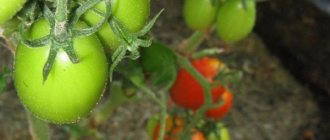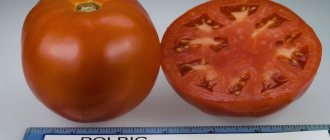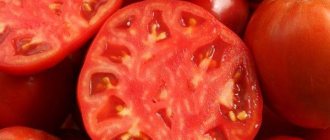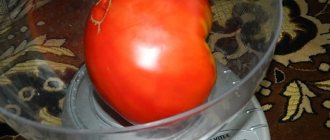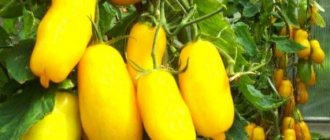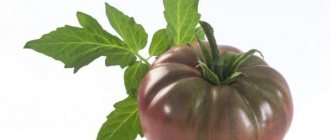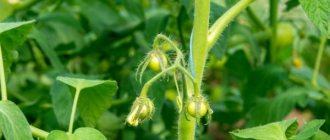» Vegetable growing » Tomatoes » Features of the Blueberry tomato
0
2662
Article rating
Thanks to the efforts of breeders, many varieties of purple tomatoes have been developed; one of the most unusual is the Blueberry tomato. This variety is endowed with all the necessary qualities - early ripening, excellent taste and resistance to many diseases.
- Advantages and disadvantages
- Features of cultivation
- Deadlines
- Seed preparation
- Planting container
- Priming
- Sowing technique
- Necessary care
- Transfer
- Preparing the bed
- Preparation of fertilizer
- Technology
- Tomato care
- Bush formation technique
- Pest and disease control
- Gardeners' opinion about the variety
Features of Blueberry tomato
Brief information about the variety
- Fruits : (purple color, weight - 150-100 g), bush - height from 1.5 to 2 m, indeterminate;
- Productivity : 8-10 kg/m²;
- Resistance : high immunity to diseases and pests is observed, frost resistance is low;
- Distribution : suitable for cultivation in the south, in the Middle and Central regions;
- Area of application of fruits : dessert purpose;
- Planting : planted in seedlings, sowing time - the last ten days of March, seed sowing pattern - distance 3-4 cm, depth - 1 cm, when transplanting to a bed - 50x70 cm;
- Soil : light soil, well-drained, enriched with organic and mineral fertilizers is suitable.
- Watering : moderate - after transplanting to the garden bed, before flowering and at the stage of fruit filling;
- Fertilizing : fertilize with nitrogen and phosphorus-potassium preparations;
- Ripening : after 95-100 days (late July or early August);
- Shelf life : in a cool place about 1.5-2 months.
general characteristics
According to the description, the Blueberry tomato variety is an indeterminate type, i.e. it belongs to the tall varieties.
The bushes need pinching and staking. Plant height varies from 1.5 to 2 m.
The foliage is medium—rich green leaves, dissected at the edges. The shoots are massive, fleshy, and from 6 to 9 fruits are formed on each of them.
Appearance of fruits
At the beginning of ripening, the fruits are green and not much different from ordinary ones, but ripe tomatoes are dark burgundy in color with a rich purple tint.
The weight of tomatoes is from 150 to 190 g. The shape of the fruit is round, the surface is glossy. They have excellent marketability and are well transported over long distances.
With their spring characteristics (color, size, formation on the bush), tomatoes resemble blueberries; of course, they are much more massive than berries, but still the name of the variety was given for a reason.
How the crop is used
The variety of American selection is intended for cultivation in amateur vegetable growing.
The fruits have a pleasant taste and are intended for desserts. Many housewives prepare various salads, ketchup, sauces and juice from it. Whole canned tomatoes are very tasty.
Description of the Blueberry tomato variety
The Blueberry tomato from Biotechnika is the result of American selection. It is based on the famous Indigo Rose variety. The new tomato has large fruits and an unusual taste.
The Blueberry variety is an early-ripening hybrid, the fruits of which are harvested 3.5 months after germination. Harvest dates vary in different regions. In the greenhouse, the tomatoes will ripen until the first frost. In the southern regions, the last harvest from open ground is harvested at the end of October.
The variety is zoned for the central zone, but is widespread in other regions of the country. Suitable for growing in open ground and greenhouses.
The plant is indeterminate, shoot growth is not organic. In open ground, the bushes reach 80–100 cm; in a greenhouse they grow more than 1.5 m. The variety is grown mainly on a trellis; pinching is required.
The shoots are powerful, well-leafed, the leaves are bright green. Flower clusters drooping, yellow flowers. Ovary formation is good, there are up to 8 fruits on one branch.
Description of fruits
Blueberry tomatoes at the beginning of growth are no different from other varieties. The fruits are green, during ripening they acquire a violet-blue color, then become dark burgundy with pronounced brown stripes at the stalk.
The tomatoes are large, average weight up to 200 g, even, round. The skin is dense and glossy. In cross-section, Blueberry tomatoes are fleshy, with a small number of seeds, and three-chambered. The flesh of the ripe fruit is completely dark burgundy in color.
Important! Gardeners rated the taste of tomatoes 4.8 out of 5. Blueberry tomatoes are sweet, without acid.
Advantages and disadvantages
The description of the Blueberry tomato variety includes one important advantage - the content of the purple pigment anthocyanin.
This substance is very useful for the body - it has a bactericidal effect, strengthens the walls of blood vessels, eliminates swelling, and increases the body's resistance to viral and bacterial infections. It is also a powerful antioxidant that prevents the development of cancer.
This variety has other positive characteristics:
- a universal crop - used for fresh consumption and processing;
- excellent transportability;
- good taste and aroma;
- unusual coloring;
- high resistance to disease;
- the yield is stable and ranges from 8 to 10 kg/m²;
- fruiting occurs 95-100 days after seed germination;
- thanks to the constant formation of flower buds, the bushes bear fruit for a long time and abundantly (when planted in a greenhouse until the end of October, in open ground - until the beginning of October);
- Regular pinching and tying up bushes can save space on the site.
Despite all the outstanding qualities of the variety, the following disadvantages are noted - poor growth, development and fruiting of tomatoes in an open garden bed.
In regions with cool climatic conditions, fruiting is later - the first harvest ripens in the last ten days of July or in the first ten days of August.
The plant is poorly resistant to severe cold; in regions with harsh climates it is grown by seedlings.
Useful properties of this variety
Blueberry tomato has a whole range of useful substances, these are:
- A huge amount of antioxidants that cleanse the body from the inside.
- Anthocyanins strengthen the human immune system, strengthen the walls of blood vessels, and are an excellent prevention of cardiovascular diseases.
- Vitamin A in the fruit perfectly strengthens vision.
- Lycopene is an excellent prevention of malignant neoplasms.
The advantage of this variety is also its ease of care and resistance to various types of pests and diseases.
Features of cultivation
Seedlings need to be well looked after
According to the description, this variety bears fruit for a long time - from July to October.
In the south, tomato seeds can be sown in open ground or in a greenhouse; in the Middle and Central latitudes, seedlings can be germinated at home and then transplanted into a greenhouse.
Those who have previously planted this variety claim that the seedling method of cultivation is more effective and productive. To obtain strong sprouts, you must follow all the details of planting and caring for crops.
Deadlines
The optimal time for sowing seeds is the last ten days of March. By the middle or end of May, the sprouts will form 2 pairs of leaves, become stronger, grow larger and be ready to be transplanted into the garden.
Seed preparation
To plant tomatoes of this variety, it is better to use purchased seeds with all the varietal characteristics of the mother plant.
Such seed has good germination and practically does not require pre-sowing preparation.
Seeds from the agricultural company Biotekhnika are sold in any gardening store and are produced in amateur packaging.
According to gardeners who previously grew this plant, the seed material corresponds to all the declared characteristics of the variety.
For those who want to play it safe, you can soak the seeds in a solution of potassium permanganate, which will destroy all pathogenic microflora. Soaking time is half an hour.
In order for the seeds to germinate faster, they should be wrapped in a damp cloth, sprayed with a spray bottle and placed in a warm and dark place for two days. To prevent the seeds from drying out, it is necessary to periodically moisten the fabric.
Planting container
You can sow seeds in plastic cassettes, seedling boxes or disposable plastic containers with a volume of 400 ml.
The main requirement for the container is a height of at least 10 cm and the presence of drainage holes for the outflow of excess liquid.
Priming
To get strong shoots, you need to select a high-quality soil composition - mix garden soil with humus and sand in a 3:1:1 ratio.
To completely destroy pathogenic microflora, the soil mixture is spilled with a highly concentrated solution of potassium permanganate or calcined in the oven.
Sowing technique
Depending on the type of planting container, different rules and seed sowing schemes apply:
- in boxes or containers for seedlings, seeds are sown at a distance of 4-5 cm from each other in grooves up to 1 cm deep;
- In disposable plastic containers or cassettes, seeds are planted to a depth of 1 cm, 2 seeds are placed in each hole.
Sowing work can begin at the end of March
The seeds are sprinkled with a thin layer of soil, the soil is slightly compacted, irrigated with water and covered with film.
Necessary care
You can germinate seedlings in a room on the south or southwest side with the possibility of shading during the midday hours.
For uniform germination and formation of strong seedlings, it is necessary to create stable temperature conditions within 23-24°C.
The optimal air humidity is 60-65%; at higher humidity there is a high risk of mold appearing on the surface of the soil. Therefore, crops are periodically ventilated. To avoid drying out, the soil is regularly irrigated with a spray bottle.
As soon as the sprouts appear, remove the cover and lower the temperature to 16-17°C during the day and 10-11°C at night. This will prevent the sprouts from stretching out and stimulate the process of growing the root system. After five days, the temperature is raised to 23-24°C.
Picking sprouts into separate containers (when planting in seedling boxes or containers) is carried out in the phase of the appearance of one pair of leaves. Before picking, the sprouts are spilled generously with warm water, which makes the process of removing them along with the earthen clod easier and reduces the risk of injury to the roots. You can transplant tomatoes into peat pots, which are convenient for planting plants in the garden.
():
When picking tomato seedlings, the tip of the root is specially pinched to form a more branched root system.
Bush formation
In open ground, when forming tomato bushes of the Blueberry variety, no special rules are followed, with the exception of breaking off the lower leaves. However, you can’t avoid shaping the tomato at all. Since stepsons are capable of growing from all leaf axils, you may end up with a large unnecessary mass of greenery.
At the end of August it is recommended to stop the growth of the main trunk. To do this, trim the top of the tomato. If the growth of a tomato is not stopped, the fruits may not ripen. When it is better to pinch the top of the stem is decided individually, based on the location of the site (climatic zone).
When growing the Blueberry tomato variety in a greenhouse, a different rule is followed. During the growth of the tomato, all the side branches and stepsons break off. Only the central trunk remains. These operations are carried out due to the fact that unnecessary stepsons absorb nutrients, thereby slowing down the growth of the main stem. Also, excess branches and leaves form unnecessary thickening, which can lead to fungal diseases (as in the photo).
Transfer
Usually this procedure is carried out in May - in the middle or at the end of the month, after waiting until the air temperature stabilizes and the soil warms up to 10-12 ° C.
In order for the seedlings to successfully take root in a new place, they are gradually hardened off. The air temperature in the room is reduced to 17-18°C. After five days of home hardening, the plants are taken outside on sunny days and left for 2-3 hours.
():
For hardening, seedlings are taken out into the open air in order to accustom the plants not only to temperature, but also to sunlight and wind.
Preparing the bed
The bed is prepared in advance - it is dug up, the remains of weeds and last year's vegetation are removed, and irrigated with a solution of copper sulfate to destroy pathogenic flora.
At a distance of 50 cm from each other, holes are dug to a depth equal to the size of the plant root system. The optimal distance in a row is 40 cm.
Preparation of fertilizer
One handful of fertilizer is placed at the bottom of each hole.
Prepare a mixture of 0.5 liters of compost, 1 tbsp. l. superphosphate, 1 tsp. urea and potassium sulfate.
Sprinkle a thin layer of earth on top and water with water - 0.5 liters per hole.
Technology
The roots of the plants are deepened, covered with soil without fertilizers and lightly hilled.
A trellis is installed along the row, which will serve as a support for the bushes in the future. Metal stakes are driven in at a distance of 0.5 m, and a wire is pulled between them.
When the tomatoes grow to a height of 30-35 cm, they can be tied to the wire using a rope.
Watering
It is important to adhere to regularity when watering Blueberry tomatoes. Moreover, it is necessary to avoid getting water on the stems and leaves.
Important! You can avoid sudden changes in soil moisture by mulching the soil surface. To do this, the soil is covered with a layer of hay and straw.
In mid-summer it is necessary to carry out more abundant watering. Due to the fact that air and soil temperatures rise, tomatoes require more water.
The volume of watering does not decrease when the fruits ripen, since the indeterminate Blueberry variety constantly blooms and bears fruit.
Tomato care
Plants need to be fertilized regularly
Basic care for this Blueberry variety of tomatoes involves several activities.
- Regular watering. The plant loves moderate humidity, so it should be watered only after the top layer of soil has dried. The first moistening is carried out 7-10 days after planting the seedlings, then watering is carried out every week. Abundant moisture is required during the period of fruit filling, which has a positive effect on the quality and taste of vegetables. The settled water is poured under the root so that moisture does not get on the stem and leaves, which can provoke the development of fungal diseases.
- After watering, the soil is loosened, weeds are removed and mulched with garden soil. Such manipulations protect the soil and roots from drying out and are necessary to maintain air and moisture permeability of the soil.
- At a certain stage of growth, different preparations are used to feed tomatoes. 1 week after transplantation, the seedlings are fertilized with a urea solution, which contains a high nitrogen content. This component promotes the rapid growth of above-ground and underground parts of plants. Proportions - for 10 liters of water use 1 tbsp. l substances. Consumption: 200 ml for each plant. The second feeding is carried out during the budding period with superphosphate and potassium sulfate (1 tablespoon per bucket of water). Consumption - 0.5 liters for each bush. The same composition is used to fertilize the bushes during the fruiting period. Phosphorus in combination with potassium ensures abundant flowering and high-quality fruiting. To increase resistance to diseases and adverse weather conditions, a tomato of this variety can be sprayed with a solution of boric acid - 0.2 g per liter of warm water (60°C). Spraying is carried out at the beginning of budding, 10 days after flowering ends.
Bush formation technique
When growing tomatoes in the south, in open ground, there are no specific rules for forming a bush. You just need to periodically tear off the lower leaves on the stem so that the plant puts all its energy into lush flowering and fruit formation.
Additionally, pluck out the stepsons that form in the axils of the leaves and form unnecessary green mass. In mid-August, the central stem is pinched. If this is not done, the plant will continue to grow, and the fruits will not ripen to the end.
When grown in greenhouse conditions, all side stems and side shoots are removed, leaving only one stem. The lateral shoots take away all the nutrients and moisture from the plant, thereby delaying its growth and development.
In addition, the thick green mass is an ideal environment for the development of various infections and the appearance of parasites.
Tomato Black Pear
As we said, the color can range from light chocolate to violet-brown, almost black.
Plants get this color from the presence of red and purple pigments. Red is found in common varieties of tomatoes, it is given by lycopene and carotenoids, but where does purple come from? It's all about anthocyanins, they are responsible for the purple color, for example, there are a lot of them in eggplants, red cabbage, etc. Anthocyanins were introduced into tomatoes through genetic engineering or natural selection.
What is special about black-colored tomatoes:
- They have a special taste due to the increased amount of sugars and a harmonious sugar-acid index.
- The presence of a large amount of antioxidants cleanses the body.
- The presence of a large amount of anthocyanins helps strengthen the immune system, as well as blood vessels.
- A large amount of vitamin A has a beneficial effect on vision.
- A high concentration of lycopene protects against tumor formation.
Usually all gardeners begin to praise black-fruited tomatoes after their first experience of growing them. So let's read about the best varieties of black tomatoes according to reviews from gardeners.
A mid-season variety of indeterminate type, it ripens in 100-115 days, has a height of up to 180 cm, so it is better to grow in greenhouses with pinching and staking. Productivity up to 7 kg per sq.m.
The fruits are a beautiful dark burgundy-brown color, round in shape, fleshy, have an average weight of 200-300 g, the first fruits can grow up to 400 g. The taste is excellent, thanks to the high sugar content, Black Prince tomatoes are richly sweet. They belong to salad varieties.
Resistance to late blight is above average, but treatment is required.
Originator: CJSC Scientific and Production Corporation NK. LTD"
A mid-early variety for growing in hotbeds and greenhouses, the fruits ripen in 100-108 days. The type is semi-determinate, bush height is 1-1.3 m. Requires staking and pinching. Can be grown in open ground in central Russia.
7-10 clusters are formed on the bush, in each cluster there are 7-10 plum-shaped tomatoes of burgundy-chocolate color, medium size, weighing 30-50 g.
The Black Moor tomato is rightfully included in the best varieties of black tomatoes, as it has excellent taste, and the fruits are dense with strong skin, so they are suitable for canning.
Originator: Sedek
Late-ripening variety (120 days), vigorous with rapidly growing vines, interdeterminate, up to 2 meters or more in height. Recommended for growing in greenhouses with obligatory pinching.
Ripe tomatoes are purple-brown, cream-shaped, weighing 60 g, dense, suitable for canning and long-term storage. Good taste, yield up to 8 kg per 1 sq.m.
Originator: Gisok
An early ripening hybrid with truly black tomatoes. It doesn’t even apply to black, but to blue tomatoes. Ripens 80 days after germination. A tall plant, interdeterminate type, reaches 150 cm. It can be grown both in greenhouses and in open ground. With garter to stakes and pinching.
The leaves are distinguished by a diamond-shaped shape and a wrinkled structure; there is no drooping, which is not typical for tomatoes.
Ripe fruits are blue-black, shiny, smooth, medium-sized, up to 50-60 g. Unripe with a plum-red gloss. The pulp is dark red, the taste is not tomato, but similar to plum.
Productivity is high, up to 6 kg per bush. Resistant to tomato diseases.
Originator: ?
Mid-season variety of black-fruited tomatoes, ripens in 110-115 days, bush type – indeterminate. The plant is tall, reaches 1.5-1.8 m, can be cultivated in greenhouses and in open ground with staking and pinching. When formed into 2 stems, the yield increases.
The fruits are original pear-shaped, weighing 50-80 g, do not crack, dense with a beautiful gloss, brown-burgundy. The taste is good, pronounced tomato. Suitable for use in salads, as well as for canning; in addition, the black pear tomato is easy to use and can be stored for a long time.
The yield per bush reaches 5 kg, you need to plant 3-4 bushes per 1 sq.m.
Originator: ?
Mid-early hybrid of interdeterminate type. From germination to the first fruits, 105-115 days pass.
The fruits are pear-shaped, 5-6 pieces in a cluster, weighing 180-200 g. Colored red-violet. Sweet and meaty to taste. Universal purpose, can be stored for a long time.
Productivity with proper cultivation is 10-12 kg per sq.m. It is better to plant 2 bushes per 1 sq.m and form them into 2 stems
Originator: ?
Mid-early (80-90 days), tall, reaches 180 cm. Recommended for growing in greenhouses in areas with a cold climate. Garter and stepson are required.
The fruits are large, some reach 500 g and above. They are flat-round in shape, greenish-brown at first, and as they ripen they darken and become almost black-burgundy. The taste is excellent, the fruits are used for juices, salads, and canning. Not stored.
The tomato variety Black Crimea is almost disease free and the yield is high.
Originator: ?
Pest and disease control
This plant is rarely affected by fungal and viral infections; this is possible if the rules of agricultural technology are not followed.
In case of damage by powdery mildew, late blight, or root rot, fungicides are used - a solution of copper sulfate or Bordeaux mixture. You can process the bushes a month before the planned harvest.
Sick plants during the fruiting phase must be disposed of.
In the fight against spider mites, whiteflies, and aphids, folk remedies are used - infusion of ash, garlic, tobacco or an ash-soap solution. At an advanced stage, insecticides are used - Aktaru, Funzadol or Karate.
():
In order not to start the problem, you need to immediately use products that really work, and not use ash, soap and garlic.
